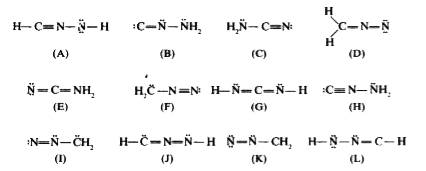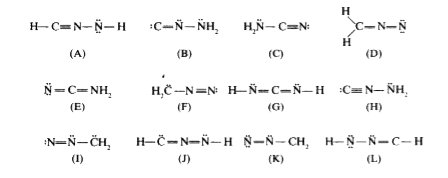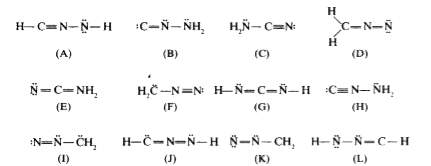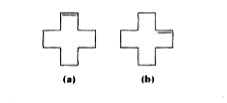Complete Solutions to SOLVED PROBLEM of chapter THE BASIC BONDING AND MOLECULAR STRUCTURE of Class 11 book with complete answers and questions
| Class 11 | CHEMISTRY |
| Chapter | THE BASIC BONDING AND MOLECULAR STRUCTURE |
| MS CHOUHAN | SOLVED PROBLEM |
| Number Of Questions | 74 |
| Academic Year | 2023-24 |
There are two constitutional isomers with the formula `C_(2)H_(6)O` . Write structural formulas of these isomers .
View Solution
View SolutionPredict the relative energies of the following resonating structures .

View SolutionThe following is one way of writing the structure of the nitrate ion:

However ,considerable physical evidence indicates that all three nitrogen -oxygen bonds are equivalent and that they have the same length , a bond distance between that expected for a nitrogen -oxygen single bond and a nitrogen -oxygen double bond . Explain this terms of resonance theory .
View SolutionThe following Lewis/Kelule structures (A) - (L) are isomeric (with molecular formula `CN_(2)H_(2)` )

Which of these structures match the following properties ? Indicate with letters (A) to (L) . If no structure fits the property write the letter X.
Which of the structures have at least one nitrogen atom with a (+) formal charge ?
View SolutionThe following Lewis/Kelule structures (A) - (L) are isomeric (with molecular formula `CN_(2)H_(2)` )

Which of these structures match the following properties ? Indicate with letters (A) to (L) . If no structure fits the property write the letter X.
Which of the structures have at least one nitrogen atom with a (-) formal charge ?
View SolutionThe following Lewis/Kelule structures (A) - (L) are isomeric (with molecular formula `CN_(2)H_(2)` )

Which of these structures match the following properties ? Indicate with letters (A) to (L) . If no structure fits the property write the letter X.
Which of the structures have at least one carbon atom with a (-) formal charge ?
View SolutionThe following Lewis/Kelule structures (A) - (L) are isomeric (with molecular formula `CN_(2)H_(2)` )

Which of these structures match the following properties ? Indicate with letters (A) to (L) . If no structure fits the property write the letter X.
Which of the structures have electron deficient heavy atoms (N or C) ?
View SolutionWrite the possible structures for the following molecules .Show the direction of the movement of electrons with the help of arrows.

View SolutionWrite the possible structures for the following molecules .Show the direction of the movement of electrons with the help of arrows.

View SolutionWrite the possible structures for the following molecules .Show the direction of the movement of electrons with the help of arrows.

View SolutionWrite the possible structures for the following molecules .Show the direction of the movement of electrons with the help of arrows.

View SolutionWrite the possible structures for the following molecules .Show the direction of the movement of electrons with the help of arrows.

View SolutionWrite the possible structures for the following molecules .Show the direction of the movement of electrons with the help of arrows.

View SolutionWrite the possible structures for the following molecules .Show the direction of the movement of electrons with the help of arrows.

View SolutionWrite the possible structures for the following molecules .Show the direction of the movement of electrons with the help of arrows.

View SolutionWrite the possible structures for the following molecules .Show the direction of the movement of electrons with the help of arrows.

View SolutionWrite the possible structures for the following molecules .Show the direction of the movement of electrons with the help of arrows.

View SolutionWrite the possible structures for the following molecules .Show the direction of the movement of electrons with the help of arrows.

View SolutionWrite the possible structures for the following molecules .Show the direction of the movement of electrons with the help of arrows.

View SolutionWrite the possible structures for the following molecules .Show the direction of the movement of electrons with the help of arrows.

View SolutionWrite the possible structures for the following molecules .Show the direction of the movement of electrons with the help of arrows.

View SolutionWrite the possible structures for the following molecules .Show the direction of the movement of electrons with the help of arrows.

View SolutionWrite the possible structures for the following molecules .Show the direction of the movement of electrons with the help of arrows.

View SolutionWrite the possible structures for the following molecules .Show the direction of the movement of electrons with the help of arrows.

View SolutionWrite the possible structures for the following molecules .Show the direction of the movement of electrons with the help of arrows.

View SolutionWrite the possible structures for the following molecules .Show the direction of the movement of electrons with the help of arrows.

View SolutionWrite the possible structures for the following molecules .Show the direction of the movement of electrons with the help of arrows.

View SolutionWrite the possible structures for the following molecules .Show the direction of the movement of electrons with the help of arrows.

View SolutionWrite the possible structures for the following molecules .Show the direction of the movement of electrons with the help of arrows.

View SolutionWrite the possible structures for the following molecules .Show the direction of the movement of electrons with the help of arrows.

View SolutionWrite the possible structures for the following molecules .Show the direction of the movement of electrons with the help of arrows.

View SolutionWrite the possible structures for the following molecules .Show the direction of the movement of electrons with the help of arrows.

View SolutionWrite the possible structures for the following molecules .Show the direction of the movement of electrons with the help of arrows.

View SolutionWrite the possible structures for the following molecules .Show the direction of the movement of electrons with the help of arrows.

View SolutionWrite the possible structures for the following molecules .Show the direction of the movement of electrons with the help of arrows.

View SolutionWrite the possible structures for the following molecules .Show the direction of the movement of electrons with the help of arrows.

View SolutionWrite the possible structures for the following molecules .Show the direction of the movement of electrons with the help of arrows.

View SolutionHow are the hyperconjugating structures drawn ?
View SolutionCompare the stabilites of the following alkenes

View SolutionCompare the stabilites of the following alkenes

View SolutionCompare the stabilites of the following alkenes

View SolutionCompare the stabilites of the following alkenes
`{:("1-Hexene","2-Hexene","3-Hexene"),("(a)","(b)","(c)"):}`
View SolutionCompare the stabilites of the following alkenes

View SolutionCompare the stabilites of the following alkenes

View SolutionCompare the stabilites of the following alkenes

View SolutionCompare the stabilites of the following alkenes

View SolutionCompare the stabilites of the following alkenes

View SolutionCompare the stabilites of the following alkenes

View SolutionCompare the stabilites of the following alkenes
(a) `CH_(3)-overset(CH_(3)) overset(|)C=CH-CH_(2)`
(b) `CH_(3)-overset(CH_(3))overset(|)(CH) =CH-CH_(2)`
View SolutionCompare the stabilites of the following alkenes

`H_(2)C =overset(CH_(3))overset(|)C-CH_(2)-CH_(3)`
View SolutionCompare the stabilites of the following alkenes
`CH_(3)-O-CH=CH_(2)`
`CH_(3) -CH =CH-CH_(3)`
View SolutionCompare the stabilities of the following carbanions :
`underset((a))(CH_(3)-CH_(2)-CH_(2))`
`underset((b))(NO_(2) -CH_(2)-CH_(2))`
View SolutionCompare the stabilities of the following carbanions :

View SolutionCompare the stabilities of the following carbanions :

View SolutionCompare the stabilities of the following carbanions :
`underset((a))(Cl-underset(Cl)underset(|)C -Cl)`
`underset((b))(F - underset(F) underset(|)(barC)-F )`
View SolutionCompare the stabilities of the following carbanions :

View SolutionCompare the stabilities of the following carbanions :

View SolutionCompare the stabilities of the following carbanions :
`underset((a))(Cl-overset(Cl) overset(|)underset(Cl) underset(|)C-bar(C)H_(2))`
`underset((b))(F - overset(Cl)overset(|)underset(F)underset(|)C-bar(C)H_(2))`
View SolutionCompare the stabilities of the following carbanions :

View SolutionCompare the stabilities of the following carbanions :
`underset((a))(H_(2)C =CH-bar(N)H)" " underset((b))(HN = CH -bar(N)H)`
View SolutionCompare the stabilities of the following carbanions :

View SolutionCompare the stabilities of the following intermediates :

View SolutionCompare the stabilities of the following intermediates :

View SolutionCompare the stabilities of the following intermediates :
`underset((a))(H-underset(H) underset(|)overset(+)C-H)`
`underset((b))(H-underset(H) underset(|)overset(+)C-H )`
View SolutionCompare the stabilities of the following intermediates :

View SolutionCompare the stabilities of the following intermediates :

View SolutionCompare the stabilities of the following intermediates :
`underset((a))(H-=C-CH_(2)-CH_(2))`
`underset((b))(H_(2)C-CH-CH_(2)-overset(+)(CH_(2)))`
View SolutionCompare the stabilities of the following intermediates :
`underset((a))(CH_(3)-O-overset(+) (CH_(2)))`
`underset((b))(CH_(3)-CH_(2)-overset(+)(CH_(2))`
View SolutionCompare the stabilities of the following intermediates :

View SolutionCompare the stabilities of the following intermediates :
`underset((a))(Cl-CH_(2)-overset(+)(CH_(2))`
`underset((b))(Cl-CH_(2)-CH_(2)-overset(+)(CH_(2))`
View SolutionCompare the stabilities of the following intermediates :

View SolutionWrite a condensed structural formula for the compound that follows :

View SolutionWrite the bond -line formula for
`CH_(3)underset(CH_(3))underset(|)(CHCH_(2))CH_(2)CH_(2)OH `
View Solution
SOLVED PROBLEM questions and complete solutions for chapter THE BASIC BONDING AND MOLECULAR STRUCTURE of MS CHOUHAN CHEMISTRY (HINGLISH) of Class 11